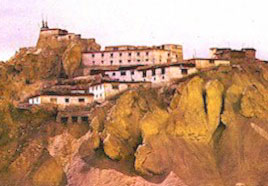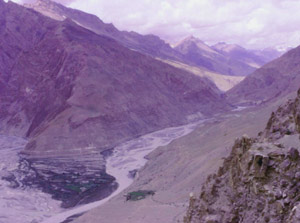| Destinations
|
|||
Mountain peaks towering at 6,000 metres, 2,500 metres deep gorges that seem to touch the core of the earth, rocks and boulders eroded by torrential rivers and high speed winds that blow across the land.. an inhospitable land that is a desert... an old desert. A land on which winter descends with fury, making temperatures dip to bone chilling figures below zero which turn gushing streams and rivers into solid masses of ice. Connected to Lahaul by the 4,590 m high Kunzam Pass and to Kinnaur by a 117 km long road that touches Sumdo in Spiti and Poari in Kinnaur, Spiti is sparsely populated. Villages are few and far between but in them live simple god-fearing, fun-loving people.
1000 year old mud walls
|
More on Himachal • At a Glance • Chamba • Dalhousie • Dharamsala • Jwalamukhi • Kinnaur • Mandi • Manali • Palampur • Renukaji • Sarahan • Shimla • Temples
Travelogues Adventure • Mountaineering • Trekking • Rafting • Paragliding • Rock climbing |
||
Priceless arts and crafts
The breathtaking murals found in the caves near the Tabo Gompa-the Ajanta of the Himalayas, the exquisitely crafted thankas and musical instruments are all tributes to the Spitian's skill. And in its arts and crafts, the Spitian's love for colour and aesthetics is richly displayed. The same zest is also evident during festivals and celebrations, community singing, dancing and feasting are the rule on such occasions and even the lamas shed their reserve to join the revellers. Namgan-celebrated on the ripening of the harvest and Namkhar the festival of horse riding and target hitting are held in the month of September-October. Dances like Shabro, Buchen and Chham set the stage for uninhibited revelry. Sights of Spiti
Sumdo: Is the entry point for Spiti, situated at the confluence of the rivers Spiti and Pare-chu, at an altitde of 3350 m. Schichiling: 50 kms. from Sumdo. From here one can take a diversion for Dhankar monastery. Attergu: From here one can turn right to enter the Pin Valley in which the road up to Kungri is available. Or turn left to trek into Lingti Valley. Kaza: Site of the famous monastery. Situated 11 kms from Kaza at an altitude of 4160 m. Losar: About 60 kms from Kaza situated near the confluence of the Losar and Peeno streams. Kunzam Pass: Situated at 4590 m. is the gateway of Spiti from Lahaul. At Lahaul, the Himalayas present a different sight. Brown barren slopes and icy rivers and streams that gush around rocks and boulders after emerging from giant glaciers. In these mountains are passes that lead to Leh, peaks that challenge mountaineers, a varied wildlife that attracts nature lovers and a terrain that is a hiker's delight. In these heights are hidden scenic spots like lake Chandra Tal, Suraj Tal and the alleys of the Chandra and Bhaga rivers that later become the Chenab on entering Kashmir. The sole across to Lahaul is the 3,915 m. high Rohtang Pass which according to legend was formed, when the mythical Tibetan King, Gyepo Gyesar hit the mountains with his magical hunting crop, to make a way to the Kulu valley. Another legend says that when the people of Lahaul approached the Hindu God Shiva, to create a path across the mountains so that they could visit the land of Kullu, the Lord hit the mountains thus creating the pass. The smile of a friend On small patches of fertile land stand Lahaul's villages, a unique society, whose people, despite the harshness of the land and their hard lives, welcome strangers with a smile that seems to light up the land itself. Their bright clothes and exquisite jewellery coupled with their infectious energy adds colour to the stark mountain land. In Lahaul the metaphysical acquires a new dimension. While Buddhism and Hinduism are the major religions, village deities ranging from a piece of cloth tied around a tree to totem poles with a trident on top and Yak's tail hair hung-aloft are also revered. Lahaul's numerous Gompas are rich store houses of Buddhist art and culture. Their lamas dominate the social fabric and no celebration function or ritual is complete without them. Amongst the Gompas, the Kardang, Gondhla, Shashur and Guru Ghantal are the most important. The temples of Trilokinath near Udaipur and Mrikula Devi also attract many devotees. Height of festive Spirit
Festivals and fairs break the monotony of Lahaul's hard life. Inevitably these are occasions for community singing, dancing and feasting.. occasions when the irrepressible nature of these people reveals itself. Reasons for celebrating are plenty, Losar (the new year festival), the birth of a son, the procession of the village deity, a marriage : to name just a few. An added attraction during festivals are the mask dances performed by the lamas of various monasteries. Donning colourful costumes, the lamas dance gracefully to the tunes of flutes, drums and bronze plates. The arts and crafts of this land are an expression of this vibrant culture. The craftsman's hands create magic that transforms jade, silver and bronze into beautiful crockery and jewellery. The magic of his brush creates the thankas that adorn most of the Gompas. While his skill creates priceless wood carvings, like the ones in the famed temples of Trilokinath and Mrikula Devi. The Sights of Lahaul Batal: One can trek to Chandra Tal and also go up to Bara Lacha Pass, on the Manali-Leh Road. Bara Shigri Glacier: Situated on the left bank of Chandra River, the mouth of this long Glacier is 4 kms from Batal. Koksar: 21 kms beyond Rohtang Pass situated at height of 3140 m. is the coldest place in Lahaul. Gondhla 18 kms from Keylong on the right bank of river Chandra. Tandi: 8 kms short of Keylong, on the Manali-Leh road situated on the confluence of Chandra and Bhaga rivers. Monasteries: Kardang -5 kms from Keylong, Shashur- 3 kms from Keylong, Tayl - 6 kms from Keylong and Guru Ghantal - 4 kms above Tandi are worth seeing. Udaipur: Home of the Mrikula Devi Temple, which is famous for wooden carvings. Trilokinath Temple: 4 kms short of Udaipur on the bank of Chenab. Suraj Tal: One of the sacred lakes situated at a height of 4883 m. and a distance of 65 kms from Keylong. Bara Lacha Pass: Situated at a height of 4883 m. on the Manali-Leh Road. Sarchu: It is the last point on the H.P.- Ladakh border. Lake Chandra Tal: Situated at a height of 4270 m and approachable through Kunzam Pass. Place: Kinnaur How to reach:
Air: Shimla is the nearest airport. Where to stay: PWD rest houses are available at Chitkul, Jangi, Kalpa, Kanam, Karcham, Moorang, Namgia, Peo, Ponda, Pooh, Rakcham, Sangla, Tapri, Urni and Yangthang. Prior permission is required from the respective Executive Engineers (PWD) or Deputy Commissioner's office. Forest Rest Houses/ Inspection Huts are also available at Akpa, Chaura, Kilba, Nichar, Purbani, Rupi, Sangla, Shaltu, Tranda for which permission has to be obtained from the respective Forest Department office. Spiti Can be approached from two routes via Manali, Lahaul and via Shimla, Rampur. How to reach:
Air: Shimla and Kullu are the nearest airports. Where to stay: PWD rest houses are available at Kaza, Lossar, Sumdo, Tabo. Prior permission is required from the respective Executive Engineer's (PWD) or Deputy Commissioner's office. Lahaul How to reach:
Air: Kullu is the nearest airport. Where to stay: PWD rest houses at Batal, Chhatru, Rangrik, Chota Dara, Gondhla, Jispa, Keylong, Koksar, Patseo, Sissue, Thriot, Tandi, Udaipur. Prior permission is required from the respective Executive Engineer's or Deputy Commissioner;s office. Restriction The Kinnaur and Spiti tribals areas of Himachal Pradesh have recently been opened to tourists and foreign nationals. Latest information on restrictions can be got from : District Magistrate- Shimla, Rekong Peo (Kinnaur), Kullu, Keylong (Lahaul) Sub District Magistrate- Shimla, Rampur, Kalpa, Nichar, Keylong, Udaipur and the additional Deputy Commissioner's office in Pooh and Kaza. Foreign nationals can travel with permits issued by these authorities only when they are travelling in a group of four or more persons with a pre-drawn itinerary through a recognized travel agent. However Indian nationals do not need permission to visit any part of Kinnaur, Lahaul or Spiti. Information: Courtesy Government of India
|
|||
Editor: Romola Butalia (c) India Travelogue. All rights reserved. |
|||
 Within the hushed corridors of the Gompas that dot Spiti's landscape, a pure form of Buddhism is practised. The diverse sects that preach the message of Buddha were the result of the development that Buddhism underwent in this valley. Built 1000 years ago, the Tabo Gompa is one of the oldest and is considered next in importance to the Tholing Gompa in Tibet. Apart from the Tabo Gompa the other important Gompas include the Dhankar Gompa that houses a deity of the Dhyani Buddha (Thinking Buddha) and a large number of scriptures in the Bhoti script. The Kee Gompa 14 kms. from Kaza, the headquarters of Spiti possesses priceless Thankas (Fabric paintings) and an array of musical instruments.
Within the hushed corridors of the Gompas that dot Spiti's landscape, a pure form of Buddhism is practised. The diverse sects that preach the message of Buddha were the result of the development that Buddhism underwent in this valley. Built 1000 years ago, the Tabo Gompa is one of the oldest and is considered next in importance to the Tholing Gompa in Tibet. Apart from the Tabo Gompa the other important Gompas include the Dhankar Gompa that houses a deity of the Dhyani Buddha (Thinking Buddha) and a large number of scriptures in the Bhoti script. The Kee Gompa 14 kms. from Kaza, the headquarters of Spiti possesses priceless Thankas (Fabric paintings) and an array of musical instruments.
 As Kullu is known as the valley of the gods, we can say Spiti is the valley of Monasteries. Monasteries like Tabo, Gulling, Dhankar and Kee are located in this valley.
As Kullu is known as the valley of the gods, we can say Spiti is the valley of Monasteries. Monasteries like Tabo, Gulling, Dhankar and Kee are located in this valley.
